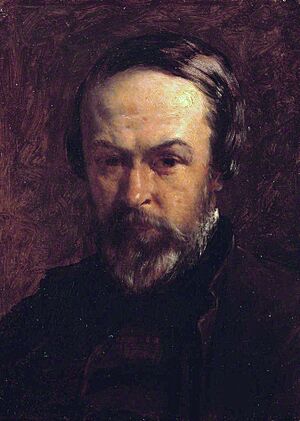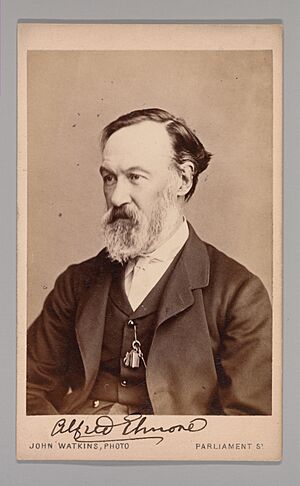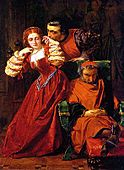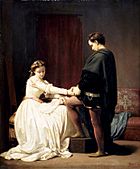Alfred Elmore facts for kids
Alfred Elmore (1815–1881) was a talented British painter. He was known for his history paintings, which told stories from the past, and his genre paintings, which showed scenes from everyday life. Elmore was also a member of the Royal Academy of Arts, a special group of artists in Britain.
Contents
Alfred Elmore's Early Life and Art
Alfred Elmore was born in 1815 in a town called Clonakilty, in Ireland. His father, John Richard Elmore, was a surgeon who had worked for the British Army. Later, his family moved to London, England.
In London, young Alfred studied art at the famous Royal Academy of Arts. His first paintings were in a style called troubadour, which was popular at the time. This style often showed romantic scenes from medieval times.
Soon, Elmore began painting religious scenes. One important work was The Martyrdom of Thomas à Becket. This painting was ordered by Daniel O'Connell for a church in Dublin, Ireland.
From 1840 to 1844, Elmore traveled across Europe. He visited many important cities like Munich, Venice, Bologna, and Florence. These travels helped him learn more about art and different painting styles.
His Connection to "The Clique"
Elmore was connected to a group of young artists called The Clique. These artists admired the works of famous painters like William Hogarth and David Wilkie.
One of Elmore's friends, William Powell Frith, said he was part of this group. However, since "The Clique" was most active when Elmore was traveling in Europe, he was probably only involved for a short time.
Telling Stories Through Art
Most of Elmore's later paintings were historical narrative paintings. This means they told stories from history. For example, some of his works showed scenes from the plays of William Shakespeare. Others depicted events from the French Revolution.
Elmore also painted about new technologies. He created two important paintings about inventions:
- The Invention of the Stocking Loom (1847)
- The Invention of the Combing Machine (1862)
These paintings showed how old ways of making things by hand were changing. They often featured an inventor thinking about how to create a machine to do the work instead.
Later Art and Life
By the late 1860s, Elmore's painting style began to change. He started to paint in a more classical way, influenced by artists like Edward Poynter and Lawrence Alma-Tadema. He also painted figures from Arabic cultures, which was a popular trend in art called Orientalism.
Elmore faced health challenges throughout his life. He suffered from a painful nerve condition. In his later years, he became lame after falling from his horse. Alfred Elmore passed away from cancer in January 1881. He was buried in Kensal Green cemetery in London.
Gallery
-
Scene from The Two Gentlemen of Verona (1857)







